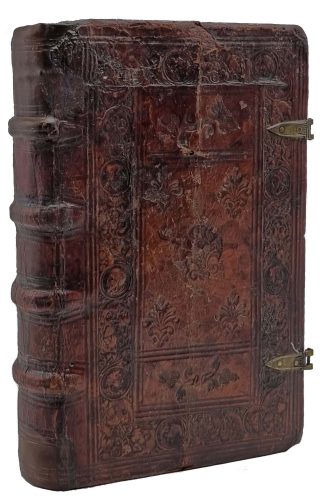VERGILIUS, Polydorus.
PRINTED EX-LIBRIS 1555
De rerum inventoribus libri octo.
Basle, apud Isingrinum, 1550.£2,750.00
8vo. pp. [48], 534, [2], last blank. Italic letter. Printer’s woodcut device to title, decorated initials. Light age yellowing, title a bit dusty at margins, very faint yellowing to upper margin of a few final ll. A very good, tall, clean copy in contemporary Netherlandish calf, lacking clasps, double blind ruled, outer border with blind roll of heads within roundels, birds and tendrils, central panel with 2 blind-stamped acorns at head and foot and blind-stamped fleurons to centre and corners, raised bands, compartments double blind ruled, head and foot of spine repaired, ancient vertical crack to upper board without loss. C20 bookplate to front pastedown, contemporary ms ‘Emptus colo[niae] 15 a[pri]l[i]s 55’, occasional contemporary ms marginalia, erased early ms ownership and printed ex-libris ‘Theodorus à Baer. 1555’ to last leaf.
A very early owner of this copy, Theodorus de Baer, purchased this volume in Cologne in 1555, and remarkably had an ex-libris produced from movable italic type, looking uncannily similar to that employed by the printer Isingrinus. This is the earliest example of a printed ex-libris we have seen.
A very good, attractively bound copy of this scarce edition of one of the most popular humanist works of the early C16. Polydore Vergil (1470-1555) was an Italian scholar, historian and diplomat who spent many years in England where he is famous for his ‘Anglica Historia’ (1513; 1534). First published in 1499, ‘De rerum inventoribus’ was a Europe-wide success, both as an encyclopaedia and intriguing schoolbook. It is a history of inventions, which identifies ‘inventors’ as ‘founders of the arts and other traditions in the distant past’ and blends, within Renaissance ‘inventio’, the modern concepts of ‘invention’ (a creation produced anew) and ‘discovery’ (finding of something that was already there and making it known) (Atkinson, pp.2, 15). Part I provides an all-encompassing compendium of the origin of the world, the gods, the birth of humankind, the origin of languages, marriage and religion, gradually moving to ‘inventors’, from antiquity to Vergil’s times, of disciplines (e.g., grammar, rhetoric, music, astrology, medicine, magic, necromancy, chiromancy, metallurgy, painting, horticulture, architecture, navigation), genres (e.g., tragedy, comedy), the city, law, the calendar, units for telling the time, and so on. Most interesting is the section on the invention of books, the first library and the ‘discovery’ of printing by Joannes Gutenberg, the first in Germany to find a way to print letters and to use a suitable new type of ink, in 1458. Nicolaus Jenson is mentioned as one of the earliest printers in Italy. The following section discusses the invention of letters, parchment and paper, mentioning Tirus, Cicero’s servant, who invented the Tironian notes, the first Latin shorthand system. Parts IV-VIII focus mainly on religion. They discuss the founding of Christianity and the sacraments, ancient Christian offices, the festive celebration of relics, the origins and later ban of marriage for priests (in which the early annotator was interested), the origins of religious sacrifices, the foundation of monastic orders, concilia and the sect of the Simoniaci. An early learned encyclopaedia.
Only Yale copy recorded in the US. USTC 684716; VD16 V 754. Not in Graesse. C. Atkinson, Inventing Inventors in Renaissance Europe (2007).In stock





